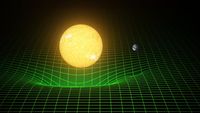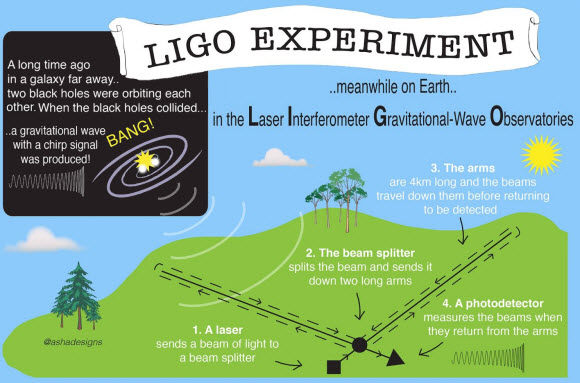 "So what are gravity waves", Prof Hendry asked? How did we detect them, and what can they tell us about the Universe. It took Einstein to figure out gravity’s true modus operandi. Gravity, Einstein showed, did not just make what goes up always come down. Gravity made the universe go round.
"So what are gravity waves", Prof Hendry asked? How did we detect them, and what can they tell us about the Universe. It took Einstein to figure out gravity’s true modus operandi. Gravity, Einstein showed, did not just make what goes up always come down. Gravity made the universe go round.
Ever since Newton discovered the laws of gravity uniting the earthly physics of falling apples with the cosmic dances of planets and stars, we have had some understanding on the nature of this force. But Newton’s laws didn’t explain how, and he refused to try. It was not until the early 20th century that a certain Albert Einstein really got to grips with gravity’s mysteries. Newton’s laws of gravity told us why the moon orbits around the Earth, Einstein told us how it knew to orbit. Far from travelling at its own pace through space, time and space were interwoven and played on the same stage as ‘spacetime’. Events that occur at the same time for one observer could occur at different times for another; this was the theory of special relativity.
But as Einstein worked on his theory of general relativity; he determined that massive objects distort space time so that it is curved. Space-time tells matter how to move and matter tells space-time how to curve.
 Imagine earth sitting in a warped and curved gravity well, with the moon following the earth within this space-time curved well. Think of space time as a grid on a stretched rubber sheet. The presence of mass then distorts space time. This warping equates to gravity.
Imagine earth sitting in a warped and curved gravity well, with the moon following the earth within this space-time curved well. Think of space time as a grid on a stretched rubber sheet. The presence of mass then distorts space time. This warping equates to gravity.
Einstein first predicted the existence of gravity waves – ripples in the curvature of space-time – caused or generated by certain gravity interactions that propagate as waves travelling at the speed of light. The strongest gravitational waves are produced by events such as colliding black holes, the collapse of stellar cores or supernova, coalescing neutron or white dwarf stars, the slightly wobbly rotation of neutron stars that are not perfect spheres, and the remnants of gravitational radiation created by the birth of the universe itself. However, as these waves spread out across the universe, those telltale signs of violent and cataclysmic processes become ever weaker, and extremely difficult to detect.
So how can such waves be detected, well, as Prof Hendry joked, it all done with smoke and mirrors, well mirrors and lasers really... LIGO (Laser Interferometer Gravitational wave Observatory). Two large observatories were built in the United States with the aim of detecting gravitational waves by laser interferometry, collecting data from 2002 until 2010. Nothing was detected. Other LIGO detectors were constructed in Sarstedt –Germany and Pisa in Italy. In 2008 work began on a major upgrade of the US facilities at Hanford, Washington and Livingstone, Louisiana, partly funded by the UK Science and Technology facilities council. The improved detectors; which ultimately will reach ten times the sensitivity of the original detectors, began operation in September 2015.

Gravitational waves squeeze and stretch space as they propagate. When the gravitational wave passes Earth it squeezes one arm of LIGO's light beam and stretches the other. The photodetector can measure the difference it causes in the light beams. As the gravitational wave oscillates, the squeezing and stretching also alternates. If an oscillation detected in LIGO's light beam matches the predicted chirp signal a gravity wave has been detected.
In 2014, there had been a false alarm when scientists announced that they had detected gravitational waves left over from the Big Bang using the Background Imaging of Cosmic Extragalactic Polarization (BICEP2) telescope in Antarctica. It is thought that such waves are embedded in the cosmic microwave background. However, further research revealed that their data was contaminated by dust in the line of sight.
On February 11th 2016 it was announced to the world that gravitational waves had been detected in September of 2015, very shortly after the advanced detectors were switched on. The initial source came from two merging black holes with solar masses of 29 and 36 respectively some 1.3 billion light years away. Energy equivalent to three solar masses was emitted as gravitational waves from the resultant 62 solar mass black hole. During the final fraction of a second of the merger, it released more than 50 times the power of all the stars in the observable universe combined. The observation also demonstrated, both the existence of binary stellar-mass black hole systems, and the fact that such mergers could occur within the current age of the universe
The detection was reported around the world as a remarkable accomplishment, making nearly a thousand front pages, efforts to directly prove the existence of such waves had been ongoing for over fifty years, and even Einstein doubted that they could ever be detected. The waves given off by the cataclysmic merger reached Earth as a ripple in space-time that changed the length of a 4-km LIGO arm by one thousandth of the width of a proton, proportionally equivalent to changing the distance to the nearest star outside the Solar System by one hair's width!
- Log in to post comments

